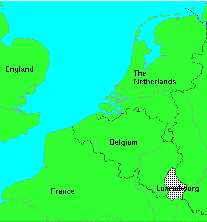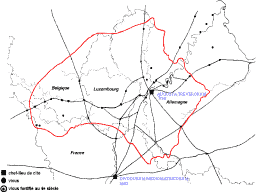
Fig. 1 The Grand Duchy of Luxembourg
Anyone interested in the excavation of burial sites in northern Gaul today immediately comes up against a major difficulty: the disparity in the scale of research in the different regions which is so great that any attempt at a general summary for the whole of northern Gaul is currently impossible. Although recent work has summarized our knowledge for other provinces in the western part of the Roman empire, as yet no such summaries exist for northern Gaul and Germania. The work of Van Doorselaer (1967) covering the whole of northern Gaul has in many respects been superseded by progress in research. Such summaries will come up against enormous practical problems until we have regional records that present in a more or less standardized fashion all the documentation now available, preferably for the different civitates.
This disparity formed the starting point for the research project, the initial findings of which are presented below. The objectives pursued fall into various categories:
The geographical framework chosen is the present Grand Duchy of Luxembourg.

Fig. 1 The Grand Duchy of Luxembourg
The choice of this geographical framework which, although it represents a major part of the civitas treverorum does not correspond to any ancient geographical entity, is explained and justified primarily by a desire for efficiency.

Fig. 2 The territory of the civitas treverorum
The fact that the ancient territory of the civitas treverorum is today spread over four modern national states (Germany, Belgium, France and Luxembourg) has led to a major fragmentation of archaeological research and has consequently brought about very disparate research in the different regions. As the human and financial resources available for research are very limited and, moreover, the aim of the project is to produce a reference summary, it seemed preferable to concentrate our efforts on the most accessible part, Luxembourg. A deliberate choice was thus made to carry out very detailed research over a limited area rather than a more superficial analysis of a wider area.
From a chronological point of view, all archaeological finds that can be dated to between the second half of the 1st century AD and the 5th century AD will be taken into account. There are several reasons for choosing the second half of the 1st century AD as the starting point for our study which are connected with the history of the excavation of Gallo-Roman burial sites (see section 5) as well as with the current state of research in Luxembourg.
In Luxembourg, archaeological activities on Gallo-Roman burial sites have concentrated, and still concentrate, primarily on the transitional period between the end of La Tène and the first decades of the Roman era, as evidenced by a whole series of recent studies either on individual cemeteries or overall surveys of the corresponding archaeological documentation.
No summary of the history of archaeological research on the city of the Treviri yet exists. It is particularly difficult to draw up a summary because ever since the 19th century the territory of the city has been divided between four different national states, Germany, Belgium, France and Luxembourg. Data concerning the area of present-day Luxembourg can be found in Ternes 1975 and Ternes 1982. A selective bibliography for the areas that are today in Germany and Luxembourg can be found in Heinen 1985. Since the 1930s, Luxembourg burial site archaeology has also begun to interest foreign scientists (Steinhausen 1936; Koethe 1939; van Doorselaer 1967; Böhme 1974). Gallo-Roman tumuli in the Grand Duchy have since been considered in two more recent regional studies by German colleagues, Ebel 1989 and Wigg 1993)
The following list of recent publications shows clearly that the excavation of burial sites continues to be one of the most important aspects of archaeology in Luxembourg: Krier 1988; Metzler, 1984; Metzler 1988; Metzler 1989; Metzler et al. 1991; Reinert 1993a; Reinert 1993b; Krier and Reinert 1991; Polfer 1996; Polfer and Thiel 1996
It would consequently have been very difficult, if not impossible, to contribute anything new on the basis of the material already published. Above all, a large number of cemeteries dating from this transitional period have recently been excavated and are still being studied. The years to come will thus see the appearance of a series of publications that will completely revise our knowledge of regional funerary rites during the first decades of Roman occupation, and invalidate any summary based on the documentation currently available.
Lastly, the present state of research enables us to identify an important gap in the geographical distribution (see section 7.1) of sites during the time of Nero, as well as changes in funeral rites (see section 7.4).
Here, however, we can present only a provisional picture of a study that is still being conducted. Although the inventory of Gallo-Roman burial sites in Luxembourg, comparing individual tombs as well as cemeteries, has now been completed, study of the archaeological material known from those sites, most of it not yet published, is only just beginning. It follows that the findings and especially the dating suggested in our report are provisional only.
© Internet Archaeology
http://intarch.ac.uk/journal/issue4/polfere/1polfere.html
Last updated: Tue Dec 09 1997